Share
Brisk July retail sales along with fewer applications for unemployment benefits underscored a US economy with staying power as inflationary pressures gradually subside.
Across the Atlantic, the UK jobless rate fell and wage growth cooled, while euro-zone productivity dropped for a sixth straight quarter and job growth slowed. Meanwhile, foreign direct investment in China slumped on investor concerns about the economy.
Here are some of the charts that appeared on Bloomberg this week on the latest developments in the global economy, markets and geopolitics:
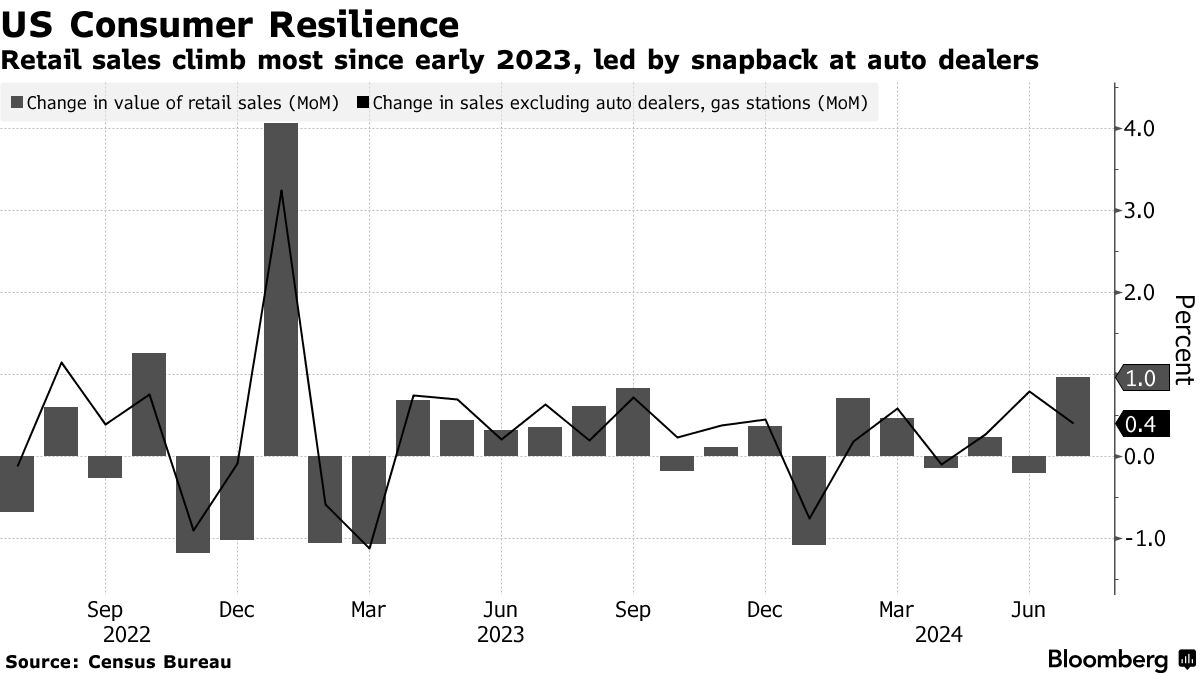
Fresh readings on retail spending and unemployment benefits quelled some of the restiveness about the US economy, parts of which remain restrained by elevated interest rates. The value of retail sales increased in July by the most since early 2023 in a broad advance and firmer sales guidance by Walmart Inc., a barometer of growth, also indicated that shoppers are becoming more selective but are still spending.
Further Progress on US Inflation
Price pressures restrained by merchandise, while rents prove sticky
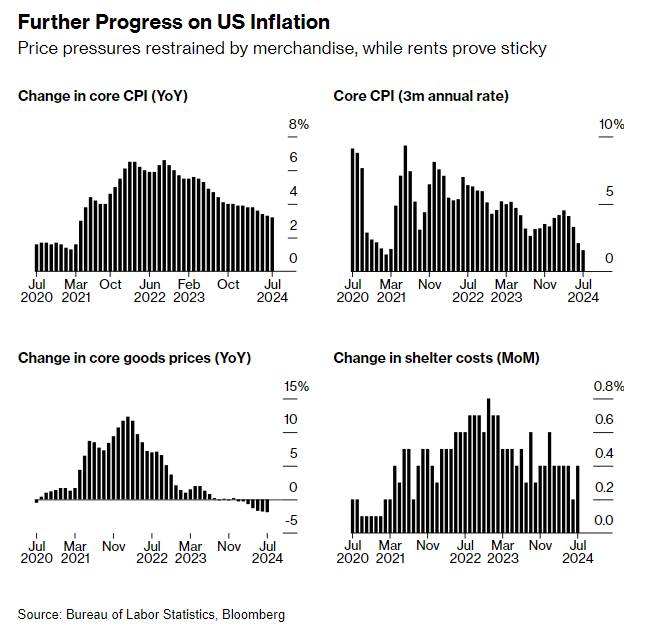
Underlying US inflation eased for a fourth month on an annual basis in July, keeping the Federal Reserve on track to lower interest rates next month. While prices fell last month for apparel, new and used cars and airfares, shelter was the most disappointing part of the report, which economists and policymakers have been widely expecting to ease and help move inflation closer to the Fed’s target.
US Labor Force Participation Rate of Young College Graduates
Under the age of 25 with at least a bachelor’s degree, 12-month rolling average (index, 100 = February 2020)
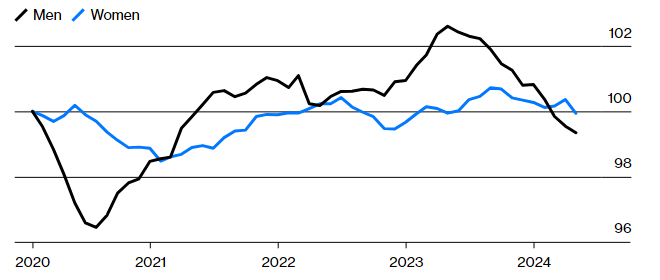 Source: Bloomberg calculations using Current Population Survey microdata (IPUMS CPS, University of Minnesota)
Source: Bloomberg calculations using Current Population Survey microdata (IPUMS CPS, University of Minnesota)While young college-educated women are sticking with their job search even as the number of vacancies shrinks, many of their male peers are choosing to take a break. The share of male college graduates participating in the workforce has declined in the past year, with 1 in 5 under the age of 25 neither employed nor actively looking for work, according to the latest 12-month average in a Bloomberg News analysis of government data.
Europe
UK Wage Growth Dips in June
Bank of England is watching the labor market carefully for signs of inflation
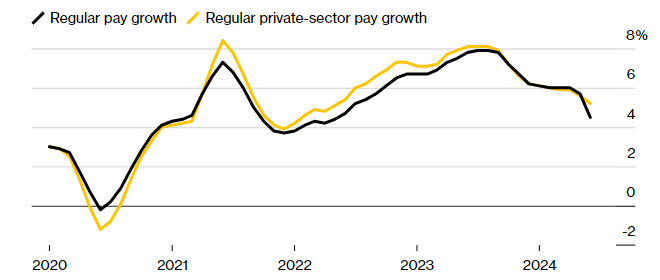 Source: Office for National Statistics
Source: Office for National StatisticsUK unemployment fell unexpectedly after companies hired at the strongest pace since November, a sign of underlying strength in the economy that complicates the Bank of England’s shift toward lower interest rates. Separate data showed regular wage growth cooled to 5.4%, the weakest year-on-year pay increase since the summer of 2022.

Firms across the euro zone slowed hiring in the second quarter amid mounting signs of economic weakness. The euro economy has sent distress signals recently, with consumers unwilling to spend despite outsized wage increases, private-sector activity grinding to a halt, and confidence in its largest member — Germany — tanking.
Euro-Zone Labor Productivity Barely Improved Last Quarter
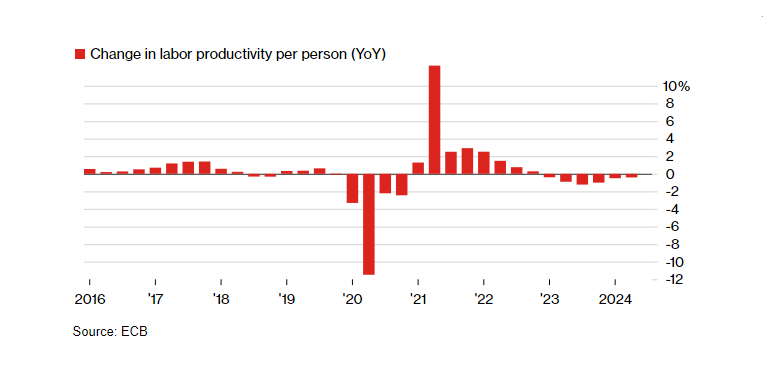 Source: ECB
Source: ECBEuro-zone productivity barely improved in the second quarter and again missed the European Central Bank’s expectations – a blow for its efforts to bring inflation back to 2%.
Economists Predict Six Consecutive ECB Interest-Rate Cuts
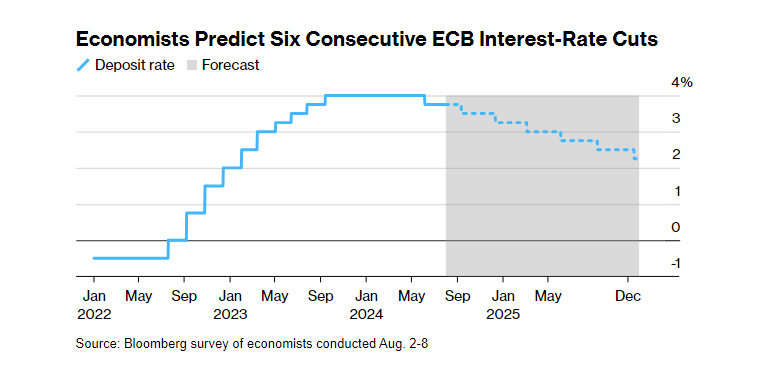 Source: Bloomberg survey of economists conducted Aug. 2-8
Source: Bloomberg survey of economists conducted Aug. 2-8The ECB is now likely to cut its deposit rate once a quarter through the end of next year, a timetable that will see its easing cycle end sooner than previously anticipated, according to economists.
Asia
Foreigners Pull Record Funds From China
Investment drops by almost $15 billion in the second quarter
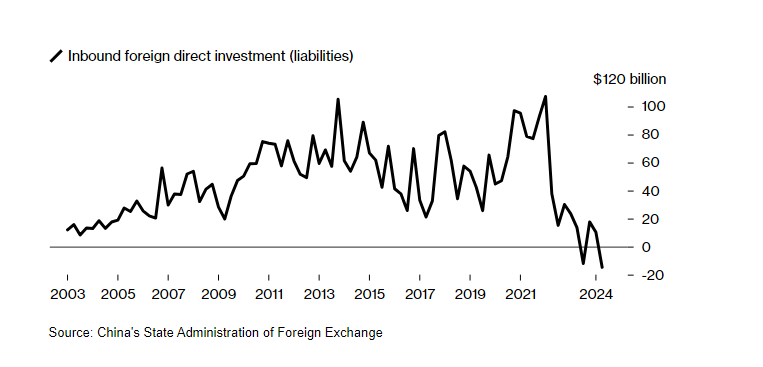 Source: China’s State Administration of Foreign Exchange
Source: China’s State Administration of Foreign ExchangeForeign investors pulled a record amount of money from China last quarter, likely reflecting deep pessimism about the world’s second-largest economy. China’s direct investment liabilities in its balance of payments dropped almost $15 billion in the April-June period, marking only the second time this figure has turned negative.

Australia’s wage growth remained elevated in the second quarter, reflecting persistent inflation pressures in the economy and supporting the Reserve Bank’s view that interest-rate cuts remain some way off.
Emerging Markets
Salaries Can’t Keep Up With Cost Of Living Under Milei
Prices of basic goods are rising far more than wages in Argentina
 Source: Argentina national statistics agency
Source: Argentina national statistics agencyIn the eight months since President Javier Milei took office, prices have soared more than 100%, consumer spending tanked and unemployment climbed as Argentines have been submitted to the most brutal austerity shock in recent history. Yet something unexpected has happened on Milei’s watch: For all the ongoing misery, he remains just as popular as when he stormed to power pledging to take a chainsaw to the state.
Africa’s Lithium Output
Raw material supply from the continent set to keep rising
 Source: S&P Global Commodity InsightsNote: Metric tons of lithium carbonate equivalent
Source: S&P Global Commodity InsightsNote: Metric tons of lithium carbonate equivalentChinese miners and refiners are driving a surge in African lithium output, shrugging off concerns over a glut to lock in future supplies of the critical battery metal. The continent is projected to account for almost 11% of global supply this year, compared with close to zero at the start of the decade, according to S&P Global Commodity Insights. That’s projected to increase to more than 14% by 2028.
World
Central Bank Watch
Change in borrowing costs this year
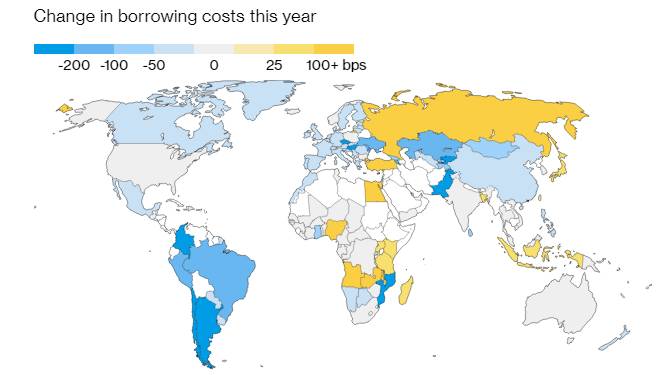 Source: BloombergNote: Mapped data show change in interest rates for distinct central banks since the start of 2024.
Source: BloombergNote: Mapped data show change in interest rates for distinct central banks since the start of 2024.New Zealand’s central bank cut interest rates, embarking on an easing cycle much sooner than previously indicated as the economy slumps and inflation slows. Namibia and the Philippines also lowered borrowing costs. Zambia’s central bank held its key interest rate after six straight hikes to support its drought-battered economy. Norway and Uruguay also stood pat.
Source: https://www.bloomberg.com/news/


